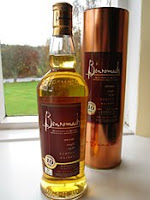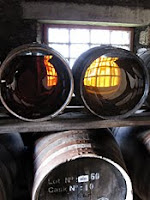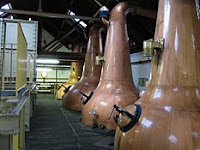Diageo, the world's leading premium drinks company, have just released their latest cask strength single malt whisky range. Whisky For Everyone were lucky enough to get an invite to the official launch and tasting that was held at Diageo's headquarters in London. The Special Release series began in 2001 and the bottlings are selected annually. The idea is to showcase special stock that they are holding from their existing and closed Scottish distilleries. This years selection is made up of nine single malt scotch whiskies and all are limited in numbers and are highly collectable and desirable as a result. They will only be able to be purchased from specialist retailers and in selected markets around the world.
 Benrinnes 23 years old
Benrinnes 23 years oldSingle malt whiskies from this Speyside distillery are rare things, so we were very interested to try this. The distillery is located close to the town of Aberlour and most of the annual 2.5 million litres of whisky produced there is used in Diageo's popular Johnnie Walker blended range. The colour is dark amber with an expressive nose. There is lots of caramel sweetness with plenty of dried fruits (especially raisins, sultanas and prunes). This is back up by some more bitter notes (think of a dark chocolate or espresso coffee) and a slight whiff of sulphuric smoke (imagine a just struck matchstick head). On the palate, this feels thick and rich, coating the inside of the mouth. The caramel, dried fruits and dark bitter elements from the nose are present and are joined by some other notes - spices (imagine cinnamon and nutmeg), something savoury (this is slightly meaty/leathery) and dark treacle. When water is added, the matchstick sulphur appears also. The finish is long and begins sweet before becoming dry, woody and spicy (cinnamon again).
Details - 58.8% ABV/sherry cask/6000 bottles/RRP £150
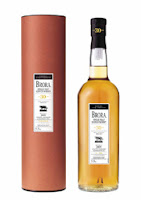 Brora 30 years old
Brora 30 years oldThe Brora distillery on the north eastern Highland coast was closed in 1983 and whisky from it are becoming increasingly hard to find as remaining stocks dwindle. This has a golden colour and a sweet smoky nose. The sweetness is reminiscent of cereal grains and butterscotch, backed up by some woody smoke (imagine an ashy bonfire) and a touch of saltiness. On the palate, this feels oily and viscous with the cereals, butterscotch, ashy smoke and saltiness (think of brine) combining with elements of vanilla, nuts (imagine roasted almonds) and a tang of citrus (especially lemon zest) that pleasantly cuts through everything. A drop of water brings out the smoke and nuttiness further. The finish is long, woody, smoky with that nuttiness coming through well again. An excellent and beautifully balanced dram.
Details - 53.2% ABV/bourbon cask/2958 bottles/RRP £230
 Caol Ila Unpeated 10 years old
Caol Ila Unpeated 10 years oldCaol Ila is a distillery that is located on the western island of Islay and is well reknowned for its peaty, smoky style of whisky. However, for just a few weeks of each year this unpeated style of whisky is produced and previous releases of it have proved extremely popular. This whisky is pale lemon gold in colour and has a fresh intense nose. There is vanilla combined with an abundance of fresh green fruits (especially pears, apple and melon). The high strength of alcohol is evident and some water softens this, bringing through something floral (think of honeysuckle) and a distinct tang of citrus (imagine lemon zest). On the palate, this is light but zingy with a grassy note and a hint of saltiness joining the fresh fruit and vanilla. Water refreshes the whisky and again brings through the floral and citrus notes as in the nose. The finish is relatively short, crisp and sweet. A very interesting whisky.
Details - 65.8% ABV/bourbon cask/6000 bottles/£48
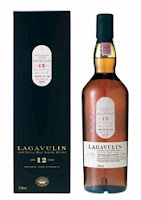 Lagavulin 12 years old
Lagavulin 12 years oldThis release from the iconic Lagavulin distillery on the western island of Islay is one of the cheapest of the collection, with a recommended retail price of under £60. The colour is a gorgeous deep amber and the nose is intense. This is full of peaty, earthy smokiness (reminiscent of wood embers and ash) and this is joined by a lovely mix of caramel, vanilla, toffee, some saltiness and a citrus element (imagine lemon zest). On the palate, this is full bodied with that smokiness marrying perfectly with some sweet barley, saltiness (think of brine), caramel and something nutty (imagine hazelnuts). With water, the whisky opens up to become even more smoky and salty with a distinct pepperiness coming through. The water also brings out a fruity element that is reminiscent of tinned fruit (pears especially). The finish is long, drying and intense with that earthy, peaty smoke fading slowly. An excellent and complex whisky that is a real bargain for the price.
Details - 59.9% ABV/bourbon cask/very small quantities - number of bottles not specified/£57
 Mannochmore 18 years old
Mannochmore 18 years oldMannochmore was built in 1971 and this modern distillery is located in the Speyside region, close to the town of Elgin. Single malt whiskies are rarely released from Mannochmore, with most being used for Diageo's popular Haig's Dimple range of blended whisky. This whisky is amber in colour and the nose begins as understated before opening up. Firstly comes some dried fruits (think of sultanas and candied peel) and vanilla, then some caramel and something slightly musty and earthy (but not unpleasant). On the palate, the whisky is light and fresh with the dried fruitiness and vanilla prominent again. The palate develops in a similar way to the nose with some caramel, nuts (imagine toasted almonds), spices (ginger especially) and a hint of something bitter (reminiscent of dark chocolate or cocoa). The finish is long, dry and spicy with the ginger particularly evident. An interesting whisky from a distillery that we have never tried before.
Details - 54.9% ABV/part bourbon, part sherry cask, part new oak cask/2604 bottles/£105
 Pittyvaich 20 years old
Pittyvaich 20 years oldThe whisky from this former Speyside distillery is very rare and this is due to the fact that Pittyvaich (pronounced pitty-vek) was closed down in 1993. It has since been demolished and stocks are running low so the opportunity to try one of their whiskies of this age was not to be missed. This bottling has also been matured in a bourbon cask rather than their traditional sherry casks. The colour is a pale gold and the nose has a fresh grassy feel to it. There is plenty of vanilla, some subtle spices (think of ginger and nutmeg) and something nutty (reminiscent of toasted almonds). The freshness is carried through to the palate, where the grassiness (imagine freshly cut grass) mingles with sweet cereal grains crisp green fruit (like pears and apples). There is a distinct nuttiness again and a slightly surprising salty tang. The finish is short but enjoyable. This is a lovely dram from an under rated distillery and is well worth trying before its stocks run out.
Details - 57.5% ABV/bourbon cask/6000 bottles/£115
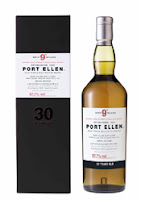 Port Ellen 30 years old
Port Ellen 30 years oldAnother whisky from a closed distillery. The legendary Port Ellen was located on the western island of Islay and closed for the last time in 1983. The stocks of its whiskies are becoming very scarce and are held in high regard by whisky drinkers and collectors alike. The colour of this 30 years old is golden with a tinge of brown. The nose is elegant with a sumptuous mix of sweet dried fruits (think of sultanas), warm spices (reminiscent of nutmeg and cinnamon), some saltiness (like sea air) and smoke (imagine coal fire smoke). On the palate, this is quite light and more subtle than many other Islay malts but still very expressive. The elements from the nose are present with the addition of a more peppery spiciness. The marriage of the coal smoke and salty brine-like flavours is gorgeous. The finish is long and warm with the smoke and saltiness prominent, with some interesting liquorice and cinnamon notes coming through at the end, especially when water is added.
Details - 57.7% ABV/bourbon cask/5916 bottles/£200
 Talisker 25 years old
Talisker 25 years oldTalisker is the only distillery on the western island of Skye. The Talisker 10 years old is one of the best selling single malts in the world but whiskies of this age from the distillery are much harder to find. The colour is a golden amber and the whisky clings to the glass as your take in the aromas. The nose is surprisingly soft and mellow with a distinct spiciness (imagine black peppercorns), some saltiness (think of seaweed especially), caramel and a meaty, almost leathery smokiness. On the palate, this is pleasantly oily and feels thick, coating the inside of the mouth. It is rich with some peppery smoke, some fruitiness (imagine sultanas and dried apple), a hint of salt (think of brine) and an interesting iodine bitterness. Very easy drinking, even at the cask strength, but is worth trying with water as this brings out some sweet citrus notes (especially orange peel). The finish is long, warming and spicy (ginger maybe?) with a more earthy peppery smokiness. Lovely stuff!
Details - 54.8% ABV/part bourbon, part sherry cask mix/5862 bottles/£150
 Talisker 30 years old
Talisker 30 years oldThis
30 years old is the second whisky in the new series from the iconic distillery on the isle of Skye. It is gentler and more subtle than the 25 years old. The nose is very fresh for a whisky of this age and has a complex mix of dried fruit (sultanas and candied orange peel especially), saltiness (imagine seaweed) and subtle spicy smokiness (think of black pepper and nutmeg). There is also some fresh toffee and a touch of earthiness. This feels thinner on the palate than the 25 with a sumptuous vanilla sweetness combining well with delicate light smoke (imagine wood ash/embers), a salty element (brine again) and dried fruits notes (although these are less prominent than on the nose). Like the 25 years old, this drinks very well at the natural strength, although adding a touch of water does bring out some sweet earthiness (reminiscent of damp moss). The finish is long with some honey and dried fruit sweetness with just a whiff of smoke and spice. Wow - this is one exceptional and complex whisky.
Details - 53.1% ABV/part bourbon, part sherry cask mix/3000 bottles/£215
Whisky For Everyone's 'whisky of the night' - Boy, this is a tough call as Diageo have really excelled themselves with this years selections. It was very interesting to sample whiskies from some of their lesser known Speyside distilleries and some of the premium whiskies from the closed distilleries but ultimately the short list consists of the two Taliskers, the Lagavulin 12 years old and the Caol Ila Unpeated 10 years old. Each are great whiskies but if we had to choose one it would be the Talisker 30 years old. It is simply fantastic.
 Birnie Moss is a single malt whisky that is released by the Benriach distillery. Benriach is an innovative distillery based in the central Speyside region, to the south of the city of Elgin. It is one of Scotland's few independently owned whisky distilleries having been taken over by the Benriach Distillery Company in 2004. They have also acquired Glendronach, another Speyside distillery, in 2008. Benriach distillery was originally founded in 1897 and has a current production capacity of 2.5 million litres per year.
Birnie Moss is a single malt whisky that is released by the Benriach distillery. Benriach is an innovative distillery based in the central Speyside region, to the south of the city of Elgin. It is one of Scotland's few independently owned whisky distilleries having been taken over by the Benriach Distillery Company in 2004. They have also acquired Glendronach, another Speyside distillery, in 2008. Benriach distillery was originally founded in 1897 and has a current production capacity of 2.5 million litres per year.




